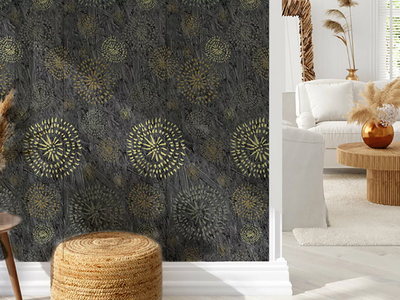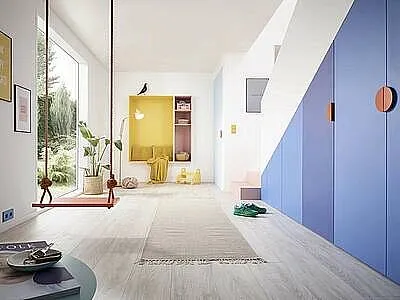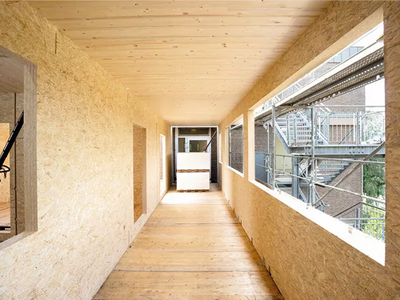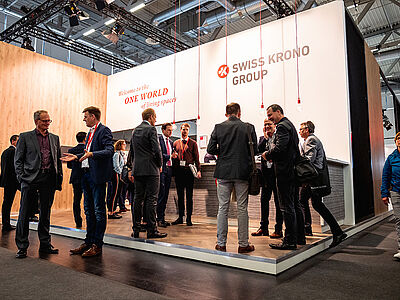The (economic) value of wooden houses
Your own house in which your children or even grandchildren might live one day – that is an absolute dream of many builders. And anyone who opts for wood and wood-based materials is now in good company. Today, the number of builders using wood or wood-based materials in the construction of residential buildings, which had been just about 7 % back in 1990s (according to “Holzbau Deutschland - Bund deutscher Zimmermeister”), is twice as high. The average current market share in Germany is 17.7%. In some federal states, the figure is well over 20%. The market leader is Baden-Württemberg with 30%, the Association for German Prefabricated Timber Constructions [Deutsche Holzfertigbau-Verband] even states it to be 34%. Modern wood construction is becoming more and more trendy – and the trend is demonstrably upward.
Wood is the most sustainable and at the same time the oldest building material in the world, it can be used flexibly and ensures indoor comfort. The environmental benefits are well known and documented. Besides, wooden houses are even extremely durable and give excellent value for money. This is where the price/performance ratio comes into play.
The use of wood-based materials in construction is both a sound and future-proof investment. Thanks to state-of-the-art processing and manufacturing technology in modern wood construction, modern wooden houses are in no way inferior to conventional stone-made buildings – neither in terms of their value preservation nor in terms of costs.
Durability of wooden houses
Houses, extensions and façades made of wood can last for as many decades as a conventionally constructed house made of stone. While in the past, a total service life of around 60 years was assumed, the wooden houses erected today have a service life of at least 100 years, most probably even much longer than that. This is partly due to the high degree of prefabrication of the individual components. In modern wood construction, entire walls and ceilings including pipes, heating and ventilation ducts etc. are prefabricated at the factory. This ensures shorter construction times and less moisture penetrates during installation. Therefore, wooden houses today are even less susceptible to moisture and the associated mould than stone houses. This again has a positive effect on durability and lasting value.
Nowadays, the useful life of property is rarely calculated or estimated according to the construction method, but much more according to equipment standards. High-quality building equipment naturally enhances the attractiveness of a property, allows a longer useful life to be expected and increases its value.
The actual useful life, however, depends strongly on the residential and user behaviour of the residents. Statistically, a repair or modernisation is planned at the earliest after 50 years. Often, however, buildings are completely renovated or brought up to the latest energy standards after only 25 years.
Financing of houses in wood construction methods
Before the dream of owning your own home comes true, almost all builders are faced with the question of solid financing. Under normal circumstances, financing forms the basis for acquiring the land, the construction and the equipment costs. Basically, the financing of a wooden house does not differ from that of a house made of concrete or stone. Nevertheless, some builders have reservations about a wood construction method. In this case, it can be assumed that the responsible financial advisor is not up to date in terms of construction technology and construction law. For more than 40 years, the quality of wooden houses has verifiably been at least on the same level as buildings constructed using conventional solid construction methods.
The requirements for sound and fire protection can be met by all types of construction. Thus there is no reason to question the financing of wood construction and to offer worse conditions. Should doubts nevertheless arise at a credit institution, an independently prepared expert report, a building insurance policy or the RAL quality mark, which distinguishes many high-quality wood construction companies, can clear up the reservations. Perhaps at this point, you should also think about another lender who basically recognises the value of wooden houses.
Most banks require the owner’s capital to be approx. 20 percent for property loans. Full financing is rather unusual. In any case, it is worthwhile to obtain different offers and to compare them exactly, because depending on the credit institution, there can be considerable differences, especially in interest rates, maturities and the owner’s capital calculation. Some banks also include KfW promotional loans, building-society loans and even own contributions that can be provided as owner’s capital.
Financial support for construction with wood
There are many different promotional programmes available for new construction, expansion and energetic renovation measures. For example, the federal, state and local governments offer low-interest loans and subsidies of varying amounts, so it is important to thoroughly examine all possibilities and conditions. This can be done conveniently, for example, with the help of the subsidy calculator from www.holz-kann.de. Here, builders can also obtain supra-regional information on subsidies for their individual building project.
The promotional programmes of the Kreditanstalt für Wiederaufbau (KfW) are well known. Particularly with regard to energy-efficient construction, builders, house buyers and owners can make use of various KfW promotional programmes. The bank grants low-interest loans if the energy standard of a KfW efficiency house 40, 55 and 70 or that of a passive house is met. The more efficient the energy standard, the higher the repayment subsidy. Important: In the case of KfW loans, it is essential to apply for them before the start of the construction project. Loans can be applied for by builders directly through KfW-Bank or through their own bank.
Financing or mortgaging?
The question of whether a house is financed or mortgaged arises when the borrower has no other security to offer than the property itself. The main difference between financing and mortgaging is that the property itself serves as collateral for the loan and thus the house is actually owned by the bank. For this purpose, a mortgage lending value is determined, which is decisive for the amount of the total amount to be lent. With this so-called mortgage, credit institutions protect themselves against a possible inability to pay of the borrower.
Read more about this topic:






